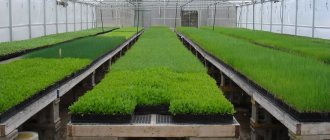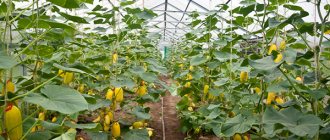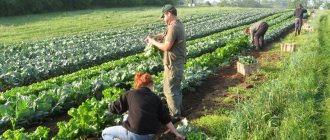Agriculture is a type of commercial activity with many nuances associated with it. The seasonal nature of production and dependence on frequently changing weather conditions makes it difficult to open and run your own business in such an industry. Moreover, in Russia this is a sector of the economy whose development the state is not happy to promote. Such factors discourage many businessmen from starting their entrepreneurial activities in agriculture.
In this case, it is important for your business to choose a niche that will always be relevant. Wheat cultivation is one of these areas of activity. Important food products are produced from this crop.
If an entrepreneur has previously had experience in agriculture, then he can safely start growing this crop. The advantage of this sector is the low level of competition. But, if you have no work experience, then you must definitely seek help from an agronomist.
By following all the stages of a business plan for growing wheat, you can create a profitable enterprise.
Search for land
Land is one of the main production elements in agriculture. Therefore, the search for a site for a business project for growing wheat must be approached as responsibly as possible. The success of the business will depend on the yield of wheat, and this in turn depends on the agrochemical characteristics of the soil. It is best to look for a plot of land in the southern regions of Russia. When choosing fields for growing wheat, it is necessary to take into account the climatic conditions in the region and the history of previous crops in a certain area.
It is also worth considering that one crop cannot be grown. If wheat is the main crop, then the selected field must be divided into several sectors where other crops will be sown. They need to be alternated with each season. This must be done so that the soil does not lose its agrochemical properties.
For a profitable enterprise, a land plot of 400 hectares will be sufficient. An average level of income can be generated by a farm with a land plot of 5 thousand hectares.
In agriculture, there is no need to buy land; here it is better to use the rental service. If for several years the cultivation of the selected crops produces a good harvest, then in this case, you can try to negotiate with the owner of the land about its purchase.
How to save 3,800 on seeds
Where else do farmers incur high costs? On seeds. Seed farms recommend sowing 5-6 million grains of wheat per 1 hectare. The brothers traveled around the world and became convinced that our neighbors sow three times less than we do. And they began to do the same. Most of us today sow 200 kg, and Peretyatko sow 60-100 kg. Therefore, on their hacienda there are no ZAVov, which cost money. There are no entrances to grain cleaning plants, no cars that transport grain from the warehouse to prepare seeds, and there are no people involved in these processes.
– We don’t spend money on this. Why, if we have only 70 tons of wheat per 1 thousand hectares of cultivated area. I saved money on this. I had to transport three times more wheat to the sowing complex, and load the complex three times more. The load is equal to the sowing time from this complex. The productivity of the sowing complex has tripled. I use fungicides per 1 ton of wheat. This means that the consumption of fungicides is reduced by three times. Insecticides are three times less. Microelements and stimulants – also in three. This is a total saving of approximately 3600-3800 rubles per hectare - only on seeds.
Here the water is purified to rainwater
Saved money is money earned, says Yuri Peretyatko. Someone went in the spring to buy 300 kg of saltpeter per 1 hectare, for which he needed a bank loan. “And the bank is making fun of him.” But Peretyatko did not spend this money in the fall. They are in the pocket of a prudent farmer. He used the savings to buy 300 kg of saltpeter per 1 hectare. And the other farmer remained in debt, and also paid interest to the bank.
“Then I took out more saved money from another pocket for 300 kg of saltpeter and in total contributed 600 kg per 1 hectare, and this food cost me less than the one who contributed 300 kg of saltpeter.
As a result, I received 80 c/ha, and he received 40 c/ha. And its cost of 40 c/ha will be more expensive than my 80 c/ha. This is where my cheap wheat comes from (last year the cost of 1 ton was 2,800 rubles) and high profitability. I saved on seeds, got clean water, and saved on fungicides, herbicides, and insecticides. Now the purchase price of wheat has collapsed. Those who have fodder work at a loss. And I have good profitability.
Necessary equipment
Purchasing equipment for growing wheat will be one of the most expensive components of the start-up investment for such a business. The list of required equipment will be as follows:
- Harrow.
- Plow.
- Seeder.
- Mowers.
- Combine.
- Tractor.
- Scraper.
- Freight transport.
- Baler.
An enterprise that grows grain crops needs to provide a place to store them after harvest. After all, sales of wheat can begin only a few months after it is harvested, during the period when the best prices will be offered for it. In order to store, for example, wheat, special elevators are installed at the enterprise. They can also be rented.
Equipment and premises
From the premises you need:
- barn for storing wheat - build it from high-quality materials so that the products do not become damp;
- garage for equipment and tool storage.
The equipment is divided into 2 types - it is intended for caring for crops and for harvesting. The most expensive is a wheat harvester, so it is advisable to rent it for a certain period rather than purchase it at the initial stage.
For personal use, purchase:
- Seeder.
- Tractor.
- Mower.
- Cultivator.
- Freight transport.
- Plow and harrow.
- Peeler.
To reduce costs, purchase equipment on credit or purchase used units. You can also rent the cars listed above, this is convenient if you have a small starting capital. If you have a decent amount of money, purchase new equipment - this is beneficial in terms of reducing repair costs.
The amount of equipment needed depends on the area being sown; if necessary, purchase several units of units to speed up sowing and harvesting. The required number of machines minimizes the need for manual labor, which allows saving on wages.
Wheat varieties for cultivation
The wheat variety for cultivation must be selected relative to the territory where the production will be located. There are the following varieties of wheat:
- feed;
- fodder;
- food
In this case, the choice of variety for cultivation should also be made based on the target audience for whom the business will work. The most profitable option will be forage varieties, but several types can be combined.
Climatic conditions will determine the type of wheat: winter or spring. Each of them must be sown at a certain time of the year. On average, about a hundred kilograms of seeds need to be prepared per 1 hectare of land, but this volume may also vary depending on the conditions of the region and the quality characteristics of the soil. One ton of seeds will cost about 6 thousand rubles.
How to collect and store wheat?
The final stage of growing wheat is harvesting. In order to accurately determine the date of the operation and to prevent grain shedding due to overripening, the farmer must constantly monitor its ripeness. Eat:
- Milk maturity. Observed in the first ten days of July. The field remains green, but the stems in the lower part begin to turn yellow, as well as the films on the grain. The contents of the seeds are similar in appearance to milk pulp;
- Waxy maturity. Observed in the second ten days of July. The stems and leaves become yellow, the ears also lose their greenish color. The grains remain soft like wax, but can be broken with a fingernail;
- Full maturity. Comes in the third decade of July. The stems and leaves dry out, and the grain acquires its natural structure and color. It is no longer possible to break it with a fingernail, but it remains elastic and is easily freed from films.
Typically, when growing wheat, farmers try to harvest fully ripened grain, although in difficult weather conditions it is better to carry out the procedure a little earlier. In the past, wheat was cut and threshed only by hand, but today combine harvesters are used on large areas:
- In direct harvesting, the combine cuts the plants, immediately threshes them and separates the stems. The grain is cleared of debris and delivered in a bunker to the granary. This method is used when the crop matures evenly and there is no lodging;
- With separate harvesting, the header mows the plants and forms windrows from them. After some drying and ripening, the wheat is picked up and threshed. The method is suitable for large numbers of weeds or uneven ripening.
It is possible to store a small amount of grain at home in bags, but it is better to take several hundred tons to a grain elevator, where optimal conditions are maintained. Of course, renting a granary will slightly increase the cost of growing wheat, but at the same time the farmer will get rid of worries about the safety of the crop. At the elevator:
- Before being placed in a granary, wheat is disinfected by treatment with high temperature, gases or aerosols;
- The seeds are additionally cleaned of weeds, dried to a moisture content of 10–12%, cooled to 12–14°C and poured into bins;
- During storage, the temperature and humidity of wheat are constantly monitored. To regulate these parameters, the room is intensively ventilated;
- Observing the recommended microclimatic conditions, food grains are stored for at least 5-6 years, and varietal seeds - within 12-14 months.
Registration
A business plan for growing grain crops includes the stage of registering business activities. Since this is the sphere of agriculture, it is best to register not an individual enterprise or an organization with limited responsibilities, but a personal subsidiary plot or a peasant farm. It is not profitable to open a small enterprise for growing grains; in such an industry it is always a question of larger-than-average production sizes. Therefore, it is worth registering a peasant farm immediately.
The total cost of this process, as well as obtaining all the necessary documents, will cost the entrepreneur 20 thousand rubles. After this, it is necessary to create a project with a feasibility study, as well as an investment plan.
Business registration
Where to start registering a business? Step-by-step instructions for opening a business begin with registration with the tax office. There you need to select the form of ownership. We advise you to choose a limited liability company. First, more implementers are willing to collaborate with organizations; secondly, LLC has more development prospects and fewer restrictions in terms of revenue and number of personnel.
As a taxation system, you can choose a single agricultural tax (20% of income), which will replace the payment of:
- VAT.
- Income tax.
- Property tax.
- Insurance premiums.
Grain growing activities are not licensed, but grain storage requires permission. The state fee for obtaining a license costs 1,000 rubles. Before submitting documents for a storage permit, you need to prepare the premises - a barn - and obtain permission from the fire services and the SES. All business registration activities will require about 170 thousand rubles.
Personnel for wheat farming business
The business plan for growing wheat also includes drawing up a list of future personnel. Since the sphere of production in agriculture has many of its own characteristics, the search for the necessary personnel requires special attention. These must be people with a certain level of qualifications and experience.
The staff will consist of the following people:
- Combiner.
- Tractor-combiner driver.
- Workers.
- Head of the enterprise.
- His deputy.
Since crop farming is seasonal, most employees will also be seasonal. It is important to find a good agronomist and sales manager.
Accounting and notary matters can be entrusted to third-party outsourcing companies. It is not profitable to maintain an accountant on a permanent basis at a medium-sized peasant farm.
Land for sowing
For a wheat growing business to be profitable, sow large areas of at least 100 hectares in size. It is not uncommon to rent plots of 1,000 hectares or more in order to get more crops and, accordingly, increase profitability and profits. When drawing up a business plan, keep in mind that large flour mills prefer to work with wholesale suppliers; they are not interested in purchasing small quantities of grain.
If the land for crops is not owned, then renting is the best option. Sign the contract for a year, and if necessary, you can extend it for the required period. The cost of a hectare of field suitable for sowing wheat varies from 14 to 17 thousand tenge; when signing a lease agreement for a large area, the price per hectare will be lower. Typically, landlords charge for the entire year at once, which is expensive for businesses, so try to negotiate a monthly payment.
There are special requirements for soil quality. Suitable for wheat:
- chernozem and chestnut soil - when growing crops on fertile lands, significant savings are obtained on fertilizers, since they are needed in minimal quantities;
- soddy-podzolic and forest gray soil - when a certain amount of fertilizing and fertilizer is applied, wheat will give a good harvest.
To obtain a bountiful harvest, you need slightly acidic or neutral soil, the pH of which is in the range of 7.5-7.7. Alkaline soil is not suitable for this crop.
How to set the price of wheat?
One of the most difficult tasks for the owner of a peasant farm for growing grain crops is setting prices. The cost of wheat will depend on the level of yield, which in turn directly depends on natural conditions. Therefore, it is not at all easy to accurately predict the pricing policy of the next season. The main factors that influence the formation of prices for grain crops on the Russian market are the following:
- weather conditions in China;
- weather conditions in Europe;
- problems with winter varieties in the United States.
It is worth noting that in the central regions of Russia it is much more difficult to predict the level of prices for grain crops than in the southern regions.
Is it profitable to grow wheat?
Under favorable conditions for growing wheat, 4–5 tons of crop can be harvested from each hectare. Accordingly, 450 tons of grain will grow on an area of 100 hectares, which is best sold in early autumn, when prices on trading floors reach 9,500 rubles per ton. Additionally, the farmer will receive 6.5 t/ha of straw, for a total of 650 tons. On average, prices for it are 2000 rubles/t:
Revenue from wheat cultivation
| Product | price, rub. | Quantity, pcs. | Amount, rub. |
| Wheat grain, t | 9500 | 450 | 4275000 |
| Wheat straw, t | 2000 | 650 | 1300000 |
| Total: | 5575000 | ||
Thus, on a plot of 100 hectares, the profitability of growing wheat will exceed 65%. It will be possible to recoup the initial investment in the business in two years:
Profitability of growing wheat
| Index | Meaning |
| Annual revenue, rub. | 5575000 |
| Annual expenses, rub. | 3285440 |
| Profit, rub. | 2289560 |
| Unified agricultural tax, rub. | 137370 |
| Net profit, rub. | 2152190 |
| Profitability, % | 65,5 |
| Capital investments, rub. | 3756300 |
| Payback period, years | 2 |
Income and expenses, profitability
In order to open a wheat growing business, you need to calculate expected expenses and income. It will be more difficult to cope with income, since it was previously indicated that the price market for grain crops is very unstable. But the costs of opening such an enterprise will be as follows:
- Payroll – about 300 thousand rubles;
- the cost of seeds is about 100 thousand rubles;
- fertilizers and other related consumables – 500 thousand rubles;
- elevator – 800 thousand rubles;
- purchase of equipment – 1300 thousand rubles;
- land rent – 300 thousand rubles;
- other expenses – 200 thousand rubles.
The total amount of starting investments for opening such a business will be about 3.5 million rubles. If we talk about profit, then for 240 tons of wheat you can get about 2 million rubles. But such calculations can only be used for a region in which weather conditions and crops are more or less stable.
It is also worth considering monthly expenses for small office supplies, utilities, rent of premises and wages. In the first season of work, it is almost impossible to get a return on investment in such a field of activity. Profit will begin to appear in the 2-3 third year of the project’s life.
Do not forget that in this business the key factor is the weather, which itself is unpredictable. To prevent your business from failing after the first season, you should not limit yourself to one or two crops for growing.
Equipment and ideas for small businesses
Grain crops: such as rapeseed, corn, wheat, rice or sunflower - travel through the regions of the country and are sent for export. And you can earn more than one million from this. Business plan on how to make a million from grain.jpg (100.94 KB) 6942 views
There is an opinion that it is impossible to open a business without start-up capital. However, using the experience of businessmen and analyzing the market for needs, you can find a business idea that does not require investment. Sometimes an idea lies under your feet - after all, the same land can serve as a source of income.
What are the benefits of intermediary services?
Business plan on how to make a million from grain 1.jpg (51.24 KB) 6942 views
Farmers (manufacturers) and traders (exporters) offer raw materials for sale at different prices - this difference is the weighty argument that encourages the buyer to turn to an intermediary. The difference often seems unnoticeable - 1 ruble or 1.5. However, with an increase in volume, “invisibility” forces the buyer to look for more profitable offers, where often a low price is a sign of illiquid quality.
Intermediaries specialize in analyzing product quality, monitoring suppliers and finding information about crops. The cost of intermediary services differs significantly from the prices of traders - in a transaction for 100 tons of grain at a price of 440 thousand rubles, the intermediary’s earnings for “briefing” the buyer with the entrepreneur will be 40 thousand rubles.
What do you need to earn money without investments?
Business plan on how to make a million from grain 3.jpg (81.89 KB) 6942 views
All you need is a phone number and the necessary information. More precisely:
1. Directory with information about regional suppliers. 2. Starter package with a favorable tariff plan for calls to various operators - you will have to communicate often and for a long time. 3. Ability to conduct business dialogue. If the required skill is not available, it can be obtained from webinars. 4. Availability of a car for face-to-face, inevitable negotiations on transactions.
Where to begin?
Business plan on how to make a million from grain 4.jpg (58.74 KB) 6942 views
Before plunging into business negotiations, it is worth finding out about the grain crops grown in the selected region (they are easier to work with), monitoring the average price and finding the most cost-effective options. A good place to start is to reach out to small farmers. Due to the lack of dry barns for storing products, they will sell the goods cheaper. In addition, farmers are always happy to pay in cash - it simplifies the transaction. If we take into account collective farms, then it is worth contacting them with already established customer contacts. Monitoring the market must be constant; one must not lose sight of the arrival of new, profitable offers.
It is also worth studying gluten deformation meters, nature and GOST standards - this will allow you to make correct conclusions about the quality of grain. An intermediary prepared in advance will save time on product examination.
It is recommended to use web resources to find clients. Unliquid grain is sold to elevators, poultry farms and feed mills. It is better to sell first-class raw materials to exporters (traders) - but the production volumes must be large.
Algorithm for concluding a deal
Business plan on how to make a million from grain 6.jpg (34.74 KB) 6942 views
Let's look at the example of purchasing 100 tons of grain crops. Intermediary actions:
1. The agency agreement concluded with the buyer will serve as a guarantee of the participation of an intermediary in the transaction. For the duration of the document, transactions between the buyer and seller without an intermediary are excluded (anyone interested can find detailed information about the preparation of the act through a search engine).
2. The intermediary finds a seller who has products in the required quality and quantity, finds out the price and discusses the information received with the client.
3. If the price is right, the intermediary goes to the farmer (seller) and inspects the goods. Often, cunning farmers pour good grain on top of the illiquid grain, so samples should be taken little by little from all ends, penetrating to the base of the storage facility.
4. The intermediary delivers several kilograms of samples to the elevator to conduct an examination. Where it is determined: the chemical composition of the grain, the quality of storage, the amount of gluten, pest infestation and the glassiness of the grain. The price for the service is 250-300 rubles. If the quality of the product is confirmed, the intermediary contacts the customer and discusses the results with him.
5. If the terms of the transaction suit the client, the intermediary calls the farmer and arranges a meeting to conclude a purchase and sale agreement. The meeting is scheduled on neutral territory. This precaution reduces the likelihood of a meeting between the buyer and the supplier, who can conclude a subsequent transaction directly - without an intermediary.
Business plan on how to make a million from grain 7.jpg (47.26 KB) 6942 views
In case of long-term cooperation with the buyer, when friendly relations have already been established, this option cannot be ruled out - the intermediary provides a purchase and sale agreement to the buyer. The buyer signs the papers. Then the intermediary delivers two copies of the agreement to the client’s accounting department for payment. The invoice is paid and the intermediary receives a percentage for the services provided. And, if this measure is specified in the contract, the intermediary controls the process of loading and transporting grain from the farmer to the buyer.
But sometimes, with trust built through numerous transactions, the intermediary receives an application for the purchase of grain, looks for the required volume and quality of products, gives the buyer contacts and receives a reward. In this case, documentation, loading, and transportation occur without the participation of an intermediary.
License and taxes
The design is similar to the topic Business idea: virtual reality attractions in the section in the “Documentation” section.
We recommend: What is interesting and profitable about a living notebook? How to increase your income with a vending business? Business plan: how to open a store selling satellite phones?
Possible risks
In agriculture, like in no other business, there are many risks. Most of them are of the unpredictable variety. Therefore, the financial plan for such an enterprise should always include an insurance fund in case of unforeseen situations. But there are also risks that cannot be predicted:
- Equipment breakdown.
- Decreased liquidity due to uneven sales.
- A sharp decline in grain prices.
- Crop failure.
In case of crop failure, enterprises always create a special insurance fund. The future possible profit of the enterprise is formed on the basis of the minimum yield indicators of a particular crop in the region. Also, prices are expected to be at an average level based on the dynamics of previous years.
Risks and benefits of business
When developing a business plan for growing wheat, take into account possible risks and ways to minimize them. These include:
- Reduced cost with high yield. To avoid financial losses, enter into futures contracts.
- Low yield. Insure the crop in this case to receive compensation.
- Delays in delivery due to equipment failure. Find several options for renting equipment.
Business benefits include:
- High demand for products.
- Low level of competition.
- There is a small financial barrier to entry into this segment of entrepreneurship.
Advertising campaign
Agriculture is a highly specialized field of activity. Here standard advertising methods will be ineffective. This is a B2B business and the search for clients takes place in a special way. It is best for a peasant farm representative to take part in various thematic exhibitions and forums. You can also organize a marketing department of representatives who will directly come to potential clients and offer their services.
You can also advertise your company in thematic magazines and on thematic websites. Agriculture is an area of activity in which various publications are an important resource of information.
Growing technology
The whole process goes through the following stages:
- Harrowing the soil, which takes from 8 to 10 days.
- Spring sowing work, which can last up to 10-15 days.
- Repeated harrowing.
- Treatment with herbicides, fertilizers, etc.
- Harvesting, which will take at least 20 days.
- Storing grain in barns.
When using modern technology and high-quality fertilizers, we can talk about high yields and good prospects for business development.
"Russagroprom-holding"
Agroinvestor magazine
May 2009
Read issue
Is it profitable to grow grain and silage yourself?
“Feed base” is a phrase often used by producers of meat, milk and eggs when talking about their companies. They spend part of the funds invested in livestock farming on renting and purchasing land, growing grain and grass, and producing animal feed. This is a non-core business, entrepreneurs admit. But their own raw materials make it possible to create a competitive cost of the main product, better control the quality of feed and not depend on their suppliers, they are sure. Those who buy feed also have their own lands: they need them to dispose of manure.
As a rule, milk producers have their own food supply - grain and silage and haylage lands, and less often - pig breeders. Broiler and egg factories do not go into crop production. Exceptions are rare (see sidebar). More often they buy and build feed mills and workshops: poultry farming requires complex feed with a large number of additives.
Only yours
Russagroprom-Holding (main specialization is the production of whole milk), when entering new regions, always begins with investments in the feed supply. “We make our first investments in crop production, and only then we develop livestock projects,” says Nikolai Dyachkov, deputy general director of the company. This was the case in the Moscow region, Vologda, Lipetsk and Vladimir regions, he lists. Now “standard investment schemes” have been developed for each region the holding is interested in, continues Dyachkov. Depending on the area of the farm - 5, 10, 15 thousand hectares - the requirements for equipment and personnel are described there. The list of economically profitable agricultural crops varies depending on the region. “In the Kuban we grow grain, sugar beets, sunflowers, corn for grain, and in the Vologda region we grow grain for fodder and grass for making hay, haylage and silage,” explains Dyachkov. Without your own food supply, it is impossible to successfully engage in dairy farming, he is sure.
The Oryol Maslovo farm (9 thousand cattle) uses only its own feed. Otherwise, it would be impossible to obtain relatively cheap milk, says Alexander Dragaltsev, the company’s general director. He occupies 12 thousand hectares with fodder, and together with pastures under the control of the farm, 30 thousand hectares. Maslovo mainly grows perennial grasses and grains. The cost of the latter is only 1.5-2 thousand rubles, Dragaltsev is proud. Self-production of feed, he continues, allows you to save up to 40% of their market price and reduces the cost of milk by 20%. At Maslovo it is 7-8 rubles/l, and they sell milk for 15 rubles/l.
Agro (Kirov region; part of the group of companies of the same name), which owns 17 thousand hectares, also has its own feed. In 2008, the company procured 2.8 thousand tons of hay, 10 thousand tons of silage and 1.6 thousand tons of haylage for 3.7 thousand cattle. But for pigs, some of the feed has to be purchased, clarifies Olga Soboleva, press secretary of Doronichy. While the company does not have a feed plant, feed for the complex with a capacity of 40 thousand animals is purchased from the Glazov Feed Plant. But this year Doronichi plans to begin construction of its own plant with a capacity of 20 thousand tons per day. The company will expand its feed base, including by acquiring land, says Soboleva. She finds it difficult to say how much more land the Doronichys will need. “Slavyanskoe” (Oryol region; 6.5 thousand beef cattle) also uses its own feed. The farm produces crops on 2 thousand hectares out of 3.5 thousand hectares of land in circulation. “[Last year] we received 58 centners of feed units from each hectare,” says general director Dmitry Ponitkin. The main agricultural crops grown are corn for silage (370 c/ha), perennial grasses for haylage and hay (300 c/ha), grain fodder (68 c/ha) and annual grasses. Self-production of feed allows you to reduce their cost, agrees Ponitkin. Grain, for example, in 2008 cost the farm 2.1 thousand rubles/t. After processing it, we received compound feed at a cost of 2.3 thousand rubles/t. “The market price of finished feed remained at the level of 7-8 thousand rubles, that is, it was 3-4 times more expensive,” compares the general director. But for increasing weight gain, factory-made feed is still more effective, he admits, because it contains more microelements and vitamins.
If a farm decides to provide itself with feed, then it tries to simplify and reduce the cost of this process as much as possible in order to influence the cost of the main product - milk and meat, Roman Kostyuk, general director (consulting in dairy farming), explains the reason for farmers’ dissatisfaction with their feed. When working with their own food supply, they encounter technological difficulties, he knows. For example, an agricultural producer has to find or train scarce specialists - agronomists, machine operators, livestock specialists who could properly organize work in the field of crop production. Independent cultivation of land also requires other costs that increase the cost of meat and milk, Kostyuk continues: for renting or purchasing land at the rate of 2-3 hectares per cow and calf, equipment, warehouses, facilities for drying and preparing feed.
Pig farmers are integrating
However, Kostyuk admits that livestock farmers are integrating into crop production, not wanting to depend on unreliable suppliers of feed raw materials: “A company can concentrate on its core business only if it has a reliable partner - a large crop production enterprise.” This is what they do in Europe, where the farm occupies only 25-50 hectares, buying feed from those who specialize in its production, he knows.
Russian farmers have similar strategies. Pork producers do not need a feed supply, says Vladimir Epishin, director of the agricultural division of Mortadel (Vladimir region; meat processing and fattening of pigs). For 100 thousand animals, 50 thousand hectares of land are required, located next to production, he says, but such sites are increasingly difficult to find. Mortadel also fattens 100 thousand pigs, but it has only 3 thousand hectares of land for manure disposal. Epishin considers feed production as a separate business that requires attracting large investments. Mortadel buys pig feed (about 700 tons/month) from one of the Vladimir factories. The cost depends on the recipe and ranges from 7-40 rubles/kg. “Theoretically,” livestock farmers do not need a feed supply, agrees Patrick Hoffman, executive director of the Otrada Gen farm (Lipetsk region; pig farming). True, his company makes compound feed on its own (10 thousand tons/year), not trusting local producers. But Otrada Gen does not grow grain, but buys it and stores it in a warehouse. Now purchases are small - 8 thousand tons / year, since the company has only 20 thousand pigs, says Hoffman. Within 6-8 years, the livestock will increase to 400 thousand, “and we will no longer be able to take risks depending on grain reserves on the market,” admits the director. He understands that he will have to invest in grain production ourselves. Hoffman calls the advantage of self-cultivation the ability to choose the most effective agricultural crops. “If you produce your own protein sources, there will be no need to buy expensive imported soybeans,” he explains. “After all, in the Black Earth Region, the cultivation of special crops is not sufficiently developed.”
Another pig-breeding enterprise, Ros-Agroregion (Leningrad and Novgorod regions), is also planning to completely switch to its own feed. Now, to fatten 130 thousand pigs per year, the company purchases them from the Gatchina feed mill, and also grows grain on 13 thousand hectares of land in the Stavropol Territory, Kaliningrad and Leningrad regions. Vasily Dudkin, general director of Rosagroregion, calls the creation of a vertically integrated holding an “anti-crisis measure.” Having our own feed base will reduce the cost of pork production, he is convinced. The cost of grain fodder, according to Dudkin’s calculations, is 3-3.5 rubles/kg, the price on the market is 5-5.5 rubles/kg, and when preparing mixed feed another 1.5-2 rubles/kg is added. This difference is important for the company, because the share of feed in the cost of a kilogram of pork is 70-75%.
You really shouldn’t count on buying feed from professionals during a crisis, Kostyuk comments. Investors, he said, will not invest in feed production because they do not understand whether livestock farmers will purchase it. Farmers will not spend money on large-scale purchases of feed, as they are not confident in their quality.
Feed depots in holdings
Livestock farms that do not have their own feed are often included in holdings that include feed business units. For example, “Suvorov” (Krasnodar Territory) has no land: another agricultural company of the group is engaged in growing green mass. “Suvorova” buys feed from her “at the prices prevailing within the holding,” says the general director of the farm, Alexander Pelikh. The land is located close to the company: from the field to the farm it is only 5 km. Every year, Suvorova purchases 37 thousand tons of green corn mass at 62 kopecks/kg, which it harvests itself. Part of the feed, already collected, is supplied to Pelihu by independent farmers for 48 kopecks/kg. The price within the holding should also be lower by at least a third, the director insists, and the average price in the region is generally 32 kopecks/kg, including cleaning. It is enough to provide yourself with food partially, and the rest “can be purchased externally,” Pelikh believes. His feed accounts for 52% of the total cost of milk production, and the cost of the latter is up to 11 rubles/liter. It is not yet possible to reduce it: 0.8 feed units are consumed per 1 centner of milk, Pelikh complains.
The Aleyskzernoprodukt holding (Altai Territory) supplies feed to the Kemerovo Chistogorsky pig farm, which is part of it. Fattening 180-200 thousand piglets/year requires 60 thousand tons of feed - no more than 10% of the total processing of Aleyskzernoprodukt, estimates Anatoly Arishin, director of the complex. According to him, feed accounts for 75-83% of costs. The holding buys grain from Altai farmers and grows it itself on 27 thousand hectares. In total, the company has 60 thousand hectares of agricultural land.
Can't live without land
One of the arguments of those who grow their own food is the need to dispose of organic waste from animal husbandry. In Maslovo they take him out to the fields. About 80 thousand tons of manure are disposed of annually. They do the same at Slavyansky. “For some of the fields - 300 hectares [out of 3.5 thousand hectares] - we do not apply chemical fertilizers, but use only liquid fractions of manure,” says Ponitkin. "Rosagroregion" transports only part of the manure to the fields, which produces 30 tons per day, the rest is stored. But Dudkin plans to change the recycling scheme and has already developed a project for the production of “highly effective biomineral fertilizers” from manure.
It is not possible for farms that prefer to buy feed to not engage in crop production at all. They also need land for manure disposal. True, they have much less land than would be required for complete self-sufficiency in food. For example, the Mortadel pig farm, which plans to utilize 48 thousand tons this year, has 3 thousand hectares for this. The company will grow feed grain in the fields, says Epishin. But this, according to him, is not the main task, the main thing is to recoup the cultivation: by investing in the application of organic matter and nitrogen fertilizers, you need to get a return in the form of a harvest. Otrada Gen exports manure (about 25 thousand cubic meters/year) to 500 hectares owned by one of the shareholders. But with the several-fold increase in livestock that the company plans, the land will not be enough, Hoffman understands. “The need for manure management will lead us to buy or lease farmland faster than just the desire to gain feed independence,” he concludes. Suvorova attracts other enterprises of its holding to dispose of manure. The company exports organic matter—30 thousand tons/year—to sites, from where plant growers pick it up.
Feed the bird
The Orenburgskaya poultry farm chose vertical integration. 20 thousand hectares of leased and own lands are occupied by barley, wheat and corn for grain. If you manage to get 30 c/ha, then your own land is enough to support the enterprise, says Fedor Sizov, general director of the poultry factory. But when a drought occurs and the yield drops to 12-13 c/ha, some of the grain has to be purchased. The average cost of grain at Orenburgskaya is 1.8-2 thousand rubles/t. The company purchases soybean and sunflower meal from third-party suppliers. Compound feed is produced at our own plant with a capacity of 100 tons/day. Its cost is 20% lower than the price of purchased factory feed, Sizov calculates.











